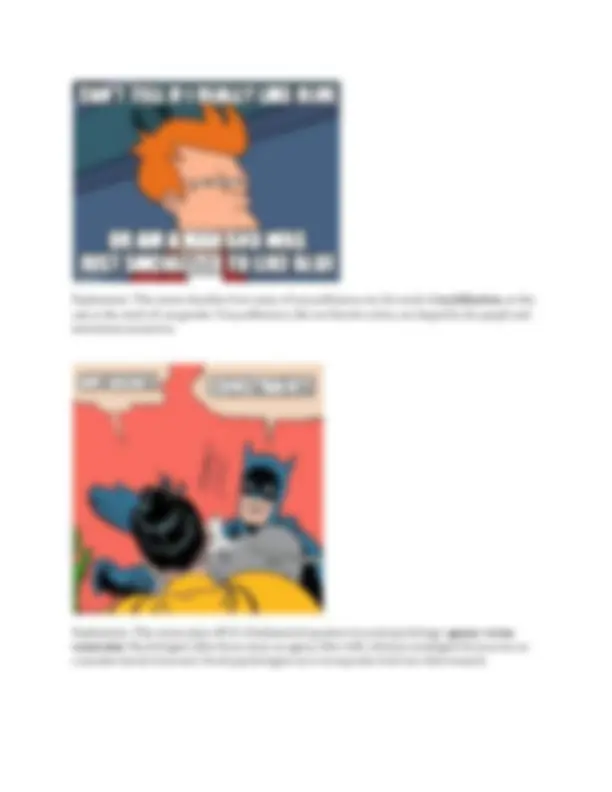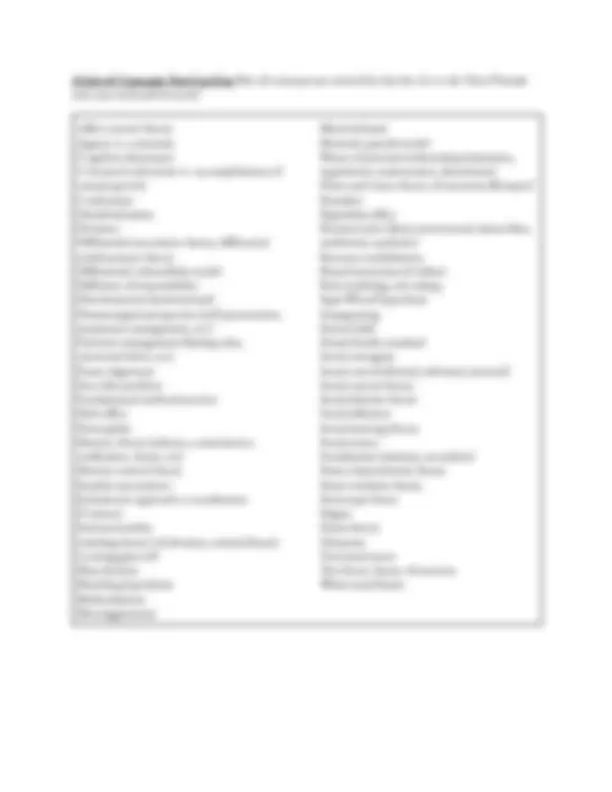




Study with the several resources on Docsity

Earn points by helping other students or get them with a premium plan


Prepare for your exams
Study with the several resources on Docsity

Earn points to download
Earn points by helping other students or get them with a premium plan
Community
Ask the community for help and clear up your study doubts
Discover the best universities in your country according to Docsity users
Free resources
Download our free guides on studying techniques, anxiety management strategies, and thesis advice from Docsity tutors
Instructions: Create an original meme related to any of the social psychology concepts we have covered in this course (in the VoiceThreads, ...
Typology: Lecture notes
1 / 4

This page cannot be seen from the preview
Don't miss anything!



Sociology 3600 Social Psychology
Due: By December 11, midnight (on Blackboard) Instructions: Create an original meme related to any of the social psychology concepts we have covered in this course (in the VoiceThreads, textbook, podcasts, etc; see the list at the end of this document for ideas). Each meme you create is worth 3 extra credit points for your quiz grade; you are able to turn in 3 memes for a total of 9 extra credit points. To be eligible for the extra credit points, you must write a short explanation (2-3 sentences) for each meme, describing how it references a class concept. Bold, underline, or highlight the concept name in each explanation (see the examples below). Turn in a single Word document with all of your memes to Blackboard by December 11 at midnight. About Memes: Memes are cultural symbols passed from person to person, usually on the Internet. Memes often draw and borrow from each other, so there are several “meme templates” you can use. Some examples are: Distracted Boyfriend (see below), Success Kid, Futurama Fry (see below), First World Problem, Crying Michael Jordan, Kermit Sipping Tea, Bernie Once Again Asking (see below), Ermahgerd, Overly Attached Girlfriend, Scumbag Steve, and more! If you are not familiar with these, I recommend browsing the popular section of/searching Know Your Meme. They explain how these memes are often used. Doing this assignment successfully means you have to pair the right meme with the right social psychological concept. Once you understand how to use a meme, you can try to �nd a course concept that will work with it. For example, the Distracted Boyfriend meme uses a picture that shows a man and woman who are presumably dating. The man is distracted by another woman walking by, and the woman he is dating is upset. Typically, people use this meme to indicate distraction from something more important or legitimate by labeling (with text) the three people in the picture. If I were to use this template to illustrate the fundamental attribution error, for example, I might create the following meme:
Here, the “distracted boyfriend” is “understanding why a person is acting the way they are.” He is getting distracted by “their personal characteristics” from the true cause, “the situation.” This is exactly what the fundamental attribution error says: that we are likely to misattribute people’s behaviors to their personal characteristics, when behaviors are really caused by the situation/environment the person is in. For my short explanation of this meme, I would write: “This meme shows the f undamental attribution error. This concept explains that people are likely to incorrectly attribute another’s behavior to their personal characteristics rather than the situation at hand.” You can create a meme using an app on a smartphone (e.g., Mematic) or one of several websites (e.g., https://img�ip.com/memetemplates). More Examples: Explanation: This meme describes self -veri�cation , or the desire for one’s identities to be veri�ed by others. Because people want their identities (e.g., a political identity) to be veri�ed by others, they engage in certain behaviors (e.g., they post political opinions on social media) that demonstrate their identities.
A List of Concepts You Can Use: Not all concepts are covered by this list. Go to the VoiceThreads and your textbook for more! A�ect control theory Agency vs. constraint Cognitive dissonance Concerted cultivation vs. accomplishment of natural growth Conformity Deindividuation Deviance Di�erential association theory, di�erential reinforcement theory Di�erential vulnerability model Di�usion of responsibility Discrimination (institutional) Dramaturgical perspective (self-presentation, impression management, etc) Emotion management (feeling rules, emotional labor, etc) Frame alignment Free rider problem Fundamental attribution error Halo e�ect Homophily Identity theory (salience, commitment, veri�cation, threat, etc) Identity control theory Implicit associations Interpretive approach to socialization (Corsaro) Intersectionality Labeling theory (of deviance, mental illness) Looking-glass self Mass hysteria Matching hypothesis Medicalization Microaggressions Moral alchemy Network-episode model Phases of personal relationships (initiation, negotiation, maintenance, dissolution) Power and status theory of emotions (Kemper) Prejudice Pygmalion e�ect Racism (color-blind, institutional, laissez-faire, traditional, symbolic) Resource mobilization Ritual interaction (Collins) Role modeling, role taking Sapir-Whorf hypothesis Scapegoating Second shift Sexual double standard Social contagion Social control (formal, informal, internal) Social control theory Social identity theory Social in�uence Social learning theory Social norms Socialization (primary, secondary) Status characteristics theory Status violation theory Stereotype threat Stigma Strain theory Tokenism Total institution Two-factor theory of emotion White racial frame